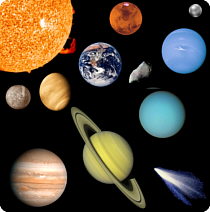 The Solar System consists of a central star, the sun, the bodies that accompany it and the space between them.
The Solar System consists of a central star, the sun, the bodies that accompany it and the space between them.
Nine planets orbit the sun: Mercury, Venus, Earth, Mars, Jupiter, Saturn, Uranus, Neptune and the dwarf planet Pluto. The Earth is our planet and has a satellite, the Moon. Some planets have satellites, others not.Asteroids are smaller rocks also rotate, mostly between Mars and Jupiter. In addition, comets are approaching and are far from the Sun
Sometimes it comes back to Earth a fragment of extraterrestrial matter. Most ignite and disintegrate when entering the atmosphere. Are meteorites.
The planets, most of the satellites of the planets and the asteroids revolve around the Sun in the same direction in nearly circular orbits. When viewed from above the north pole of the Sun, the planets orbit in an opposite direction to move clockwise.
The Sun contains 99.85% of all matter in the solar system. The planets condensed out of the same material that formed the Sun, contain only 0.135% of the mass of the solar system. Jupiter contains more than twice the matter of all the other planets combined.
The satellites of the planets, comets, asteroids, meteoroids, and interplanetary medium constitute the remaining 0.015%.
Almost all of the solar system by volume appears to be an empty space we call “interplanetary medium.” Includes various forms of energy and contains primarily, interplanetary dust and gas.
Have since been released HUGE ships. The astronauts have walked on the moon. Vehicles equipped with instruments have visited a few planets and have been through the solar system.
Further, the nearest star is Alpha Centauri. Their light takes 4.3 years to get here. She and the Sun are just two of the 200 billion stars that make up the Milky Way, our galaxy.
There are millions of galaxies that move through intergalactic space. Of all the universe formed, whose boundaries have not yet seen. But astronomers are still investigating …
 Follow
Follow